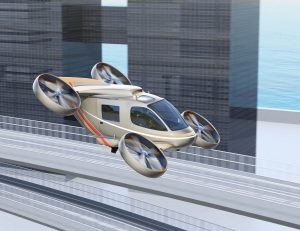When it comes to the transportation of the future, a few technologies stand out in particular: electric vehicles, autonomous vehicles, and vertical takeoff and landing vehicles (VTOL). The latter is frequently designed to be electrically powered (eVTOL) and autonomous as well. A great deal of excitement and interest has gathered around urban air mobility (UAM), which would involve taking eVTOLs into urban airspaces for both passenger and cargo transport, reducing ground traffic.
While the UAM industry is still getting off the ground, so to speak, multiple prominent startups and OEMs are working to develop conceptual vehicles, creating an already-competitive market. In order to stay ahead of this emerging industry, these manufacturers must take advantage of new tools and methods to streamline the design process.
Several challenges exist in designing eVTOLs, including determining the appropriate configuration of the airframe 
structure. This requires the study of multiple design iterations as well as collaboration with flight mechanics engineers for loading requirements.
Recently, members of SIMULIA and CATIA conducted a study in which simulation and 3D modeling were used on the 3DEXPERIENCE platform to create an efficient workflow for structural sizing based entirely on parametric design data. Thanks to full associativity between simulation models and parametric design data, the time and effort required to design the airframe structure was greatly reduced.
The study’s engineers first created the parametric design model with a combination of graphic visual scripting and interactive 3D modeling using the CATIA xGenerative Design application.
Based on an initial design of the vehicle’s external aerodynamic surface, this browser-based, on-the-cloud application allowed the engineers to design logic to parametrically build all required components of the internal structure, including ribs, spars, frames, and stringers. This enabled them to easily regenerate structural models of alternate model configurations by modifying parameters, such as number of ribs or stringers, or location of front and rear spars.
Balanced external loads in critical flight conditions must be known for structural sizing. In any given flight condition, the vehicle is subjected to aerodynamic loads, rotor forces, gravity and inertia loads. Thanks to the 3DEXPERIENCE platform, using the Fluid Dynamics application, the engineers had already set up a CFD model fully associated with design, to size the external surfaces and determine the aerodynamic loads of the conceptual eVTOL vehicle as a function of angle of attack, Mach number, etc. Rotor forces, balancing aerodynamics, inertia and gravity loads were then computed to ensure flight loads equilibrium. This external load database was used to feed the structural model of the eVTOL, which is fully associated with its CFD model. Finally, the engineers applied a combination of parametric and non-parametric structural optimization techniques to determine an optimized configuration and sizing for the conceptual vehicle.
For parametric simulation models built in the 3DEXPERIENCE platform, the new Parametric Design Study application provides an intuitive and easy-to-use interface for setting up design of experiment studies. Using this application, a parametric design study was performed for the eVTOL vehicle considering various design responses such as stresses, displacements and mass. With the data generated in this study, the engineers created approximations for the design responses and performed a parametric optimization that aimed at minimizing mass for a targeted stress level.
Once an optimized combination of design parameters was found, they performed a non-parametric Tosca Structure sizing optimization to further reduce the structural mass by optimizing the distribution of skin thicknesses and stiffener properties for the entire structure.
The tight integration of parametric design, simulation and optimization within the 3DEXPERIENCE platform greatly benefited the proposed workflow for conceptual structural sizing. The xGenerative Design application makes parametric design accessible to all designers without complex programming. As structural simulation models are fully associated with the parametric design, it becomes easy to automate the exploration of a large number of design configurations and perform parametric optimization runs.
By combining parametric and non-parametric optimization techniques, the engineers ensured that their design had the lightest possible structure that met requirements. The Fluid Dynamics application allowed them to generate aerodynamic loads, which depend on the external shape of the vehicle, by performing CFD simulations directly on the native geometry and to update the loads whenever the design itself was updated.
Learn more about the conceptual design study by watching the recent 3DEXPERIENCE Modeling and Simulation Conference presentation entitled “Conceptual Sizing Optimization for Urban Air Mobility,” given by Vishal Savane, SIMULIA Strategic Initiatives Portfolio Technical Specialist, and Rohan Keswani, CATIA Knowledgeware Portfolio Management Specialist. You can access the presentation here. Please note that you will be asked to log in or register; once you have done so, please click or copy and paste the above link a second time to be taken to the correct destination.
On June 22nd, a Live Panel Discussion entitled “Virtual Development of eVTOL Vehicles and Drones with Simulation” will be taking place. You can register for this free, one-hour event here.